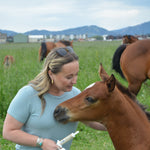My Mare’s About to Foal....Now What?
May 15, 2020

Key Takeaways:
- Prepare your mares so colostrum will equip newborn foals with disease-fighting antibodies.
- Use your foal watch resources wisely: Use FullBucket Foal Indicator strips and then look for additional foaling signs.
- Address the foaling environment and its contaminants to protect the foal from getting sick.
- Get necessary nutrients into the newborn foal via Foal Kick Start on day 1 and Foal Probiotic Paste on days 2 through 7.
- Don't forget the (correctly timed!) new foal exam.
It can seem like a watched mare never foals. Weeks upon weeks of foal watch are draining, but by predicting when she will foal with foal alert systems and milk pH tests you can better focus your watch party efforts.
Dr. Rob Franklin, an equine internal medicine specialist and co-founder of FullBucket, has spent decades advising horse owners and breeding farm managers on newborn foal care, even establishing neonatal intensive care units at veterinary clinics.
“Whether you run a large breeding farm in Lexington or Ocala, where you’ve got night staff that’s there to watch these mares, or you’re going to breed one mare at home and you want to be there for the big event, our foal pH prediction kits will basically tell you the three-day window when that mare is going to foal,” he says, based on the acidity of a few drops of the mare’s milk.
Monitoring foaling is important because if the mare gets in trouble for more than 20-30 minutes, her foal’s chances of surviving plummet, he explains.
“Using the pH strips is a great way to time your effort. Some signs a mare is going to foal include:
All of these signs tell me to get prepared,” he says.
If you have a clean (picked of manure) grassy pasture in which you can monitor the mare and the weather is good, that’s a great place for the mare to foal. Do not put her out on a dirt paddock for foaling. If you want your mare to foal indoors, select a safe stall about twice the size of a normal stall. Clean it of all manure and other organic debris, then spray surfaces with a disinfectant. After the stall dries, bed it with plenty of clean straw or straw over clean shavings.
Taking these precautions will help prevent Salmonella, E. coli, Rhodococcus equi, rotavirus and Clostridium difficile infections in foals.
“If you’re foaling out multiple foals, a foaling stall can become a dangerous environment, because if you get one foal that has something, and that mare and foal come out of the stall, and you put another mare in there to foal, that’s how I see a lot of outbreaks on these farms,” says Franklin.
New Foal Care: Help Them Thrive on Arrival
Veterinarians assess foals according to a 1, 2, 3, time frame, starting at birth.
At one hour they expect the baby to have stood up; at two, suckled; and at three, the mare should have cleared the placenta in its entirety.
Once the foal is born and Franklin has ensured the foal’s head is clear of placenta or amnion (Be sure to save the placenta for examination!), he says he typically leaves her and the baby alone for a little while so she can clean up and bond with the foal.
Then it’s time for more cleaning; be sure to clean her udder—the teat, the whole mammary gland—with warm, soapy water before the foal, likely teetering around by now, begins to try to nurse.
“That foal is going to be suckling around, looking for their first meal,” explains Franklin, and, “in that time it’s going to be consuming bacteria from the mare’s skin, tail and even the stall walls. Those foals nurse everywhere before they finally find the teat.
“The colostrum is what the body absorbs, and those antibodies get into the bloodstream where they act as a surrogate immune system until the foal can generate its own immune system,” he adds.
Another way to protect the foal from harmful bacteria during this crucial period is to give him half a tube of Foal Kick Start, which lines the entire gastrointestinal tract with antibodies.
“The antibodies in Foal Kick Start help protect the foal from any pathogens, or disease-causing organisms, such as E. coli or Salmonella,” says Franklin. “The colostrum meal and Kick Start work together to protect the foal. The colostrum acts on the entire body, while the Foal Kick Start works locally.”
Be sure to have your veterinarian out anywhere from 12 to 24 hours after birth for a mare and new foal exam; he or she can take a blood sample to confirm that the foal got enough colostrum, evident as antibodies gained via passive transfer of immunity.
By preparing your mare to equip your foal with a robust immune system, choosing a clean environment for foaling, supplementing your foal with FullBucket’s Foal Kick Start on day 1 and Foal Probiotic on days 2-7, and calling your vet for a timely new foal exam, you’re setting the stage for your foal’s healthy beginning.
FullBucket’s Foal Starter Kit was designed to offer you complete peace of mind as you (and your mare!) prepare for foaling. This is the easiest and most comprehensive way to thrive during the entire foaling process and set your foal up for lifelong success.
